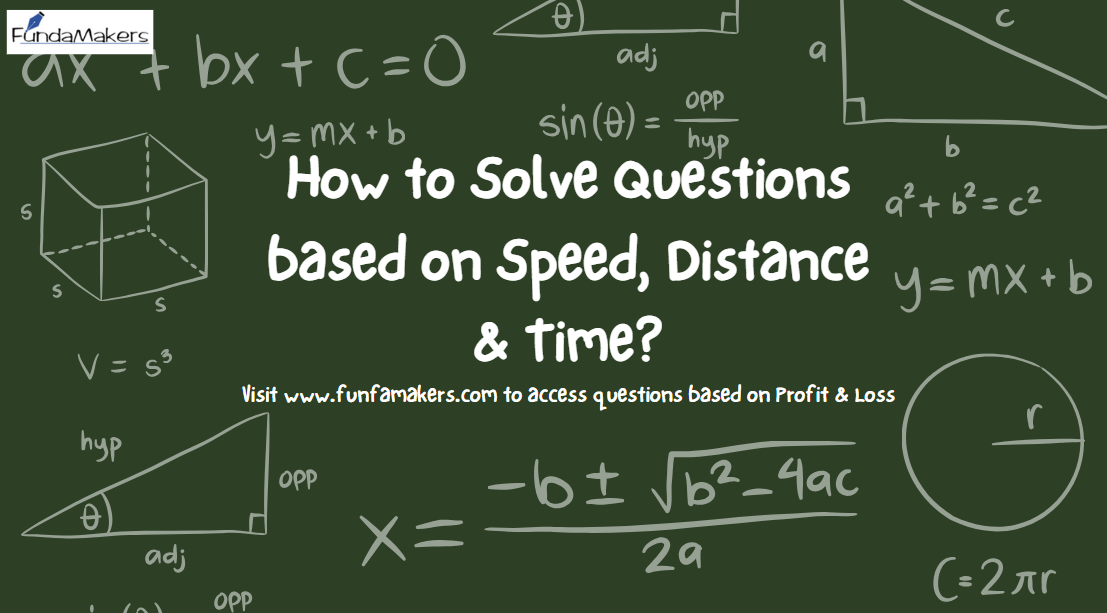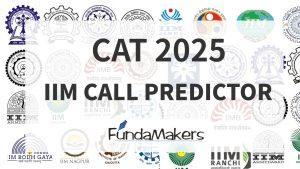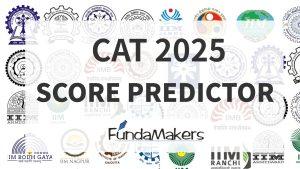Speed Distance Time is one of the most common and crucial topics covered in any competitive exam’s Mathematics or Quants part. The concept of speed, time, and distance is widely employed in queries about a variety of issues, including straight line motion, circular motion, boats and streams, races, clocks, etc. Aspirants should endeavour to understand the interrelationship of speed, distance, and time.
Relationship Between Speed, Time & Distance
- Speed = Distance/Time – This tells us how slow or fast an object moves. It describes the distance travelled divided by the time taken to cover the distance.
- Speed is directly Proportional to Distance and Inversely proportional to Time. Hence,
- Distance = Speed X Time, and
- Time = Distance / Speed, as the speed increases the time taken will decrease and vice versa.
Units of Time. Distance & Speed
Speed, distance, and time can all be described in different units.
Time: seconds(s), minutes (min), hours (hr)
Distance: (meters (m), kilometers (km), miles, feet
Speed: m/s, km/hr
So, if Distance = km and Time = hr, then Speed = Distance/Time, with units of km/hr.
Now that we’ve defined the units of speed, time, and distance, let’s look at the conversions between them.
The following are a few subheadings under the Speed, Time, and Distance subjects that explain the foundation for the range of problems answered in the exam.
Average Speed = (Total distance traveled)/(Total time taken)
Case 1 – When the distance is constant: Average speed = 2xy/x+y; Where, x and y are the two speeds at which the same distance has been covered.
Case 2 – When the time taken is constant: Average speed = (x + y)/2; Where, x and y are the two speeds at which we traveled for the same time.
Solved Examples
Q.1. A man travels from one place to another at 40 km/hr and returns at 120 km/hr. If the total time taken is 4 hours, then find the Distance.
Solution.
Here the Distance is constant, so the Time taken will be inversely proportional to the Speed. Ratio of Speed is given as 40:120, i.e. 1:3
So the ratio of Time taken will be 3:1
Total Time taken = 4 hours; Time taken while going is 3 hours and returning is 1 hour.
Hence, Distance = 40x 4 = 120 km
Q.2. A train travels with a speed of 162 kmph and crosses the pole in 10 seconds. If the length of the bridge is 75% of the length of the train, then find the time taken by the train to cross the bridge (in sec).
Solution
Given, A train travels with a speed of 162 kmph and crosses the pole in 10 seconds; the length of the bridge is 75% of the length of the train
Formula used: the length of the train = u*t
where, u is the speed of the train; t, is the time taken by the train to cross the pole
The time is taken by the train (of length x) to cross the bridge (of length y)= x+y/u
Calculation: The speed of the train= 162* 5/18= 45 seconds
The length of the train= 45*10= 450 m
The length of the bridge = 75% of 450= 337.5m
The time required by the train to cross the bridge= 450+337.5/45= 457.5 seconds
Inverse Proportionality of Speed & Time
Speed is inversely proportional to Time when the Distance is constant. S is inversely proportional to 1/T when D is constant. If the Speeds are in the ratio m:n then the Time taken will be in the ratio n:m.
There are two methods to solve questions:
- Using Inverse Proportionality
- Using Constant Product Rule
Q. 1. The speed of the train is inversely proportional to the number of wagons attached to it. The speed of the train is 90 km/hr when 12 wagons are attached to it and it crosses a platform in 23 s. Find the time in which the train will cross the platform when 10 wagons are attached to it.
Solution.
90 km/hr = 90 x (5/18) m/s
= 25 m/s
Speed 1/No. of wagons
Speed = K/No. of wagons (K= proportionality constant)
25 = K/12
= K = 300
When 12 wagons are attached the speed of train is 25 m/s and crosses the platform in 23 s.
Length of platform Speed x Time
= 25 x 23 = 575 m
When 10 wagons are attached speed of train K/No. of wagons
300/10
= 30 m/s
Time taken to cross the platform when 10 wagons are attached length of platform/speed of train
= 575/30
= 19.16 s
Q.2. After traveling 50km, a train meets with an accident and travels at (3/4)th of the usual Speed and reaches 45 min late. Had the accident happened 10km further on it would have reached 35 min late. Find the usual Speed?
Solutions:
Using Inverse Proportionality Method
Here there are 2 cases
Case 1: accident happens at 50 km
Case 2: accident happens at 60 km
Difference between two cases is only for the 10 kms between 50 and 60. The time difference of 10 minutes is only due to these 10 kms.
In case 1, 10 kms between 50 and 60 is covered at (3/4)^th Speed.
In case 2, 10 kms between 50 and 60 is covered at usual Speed.
So the usual Time “t” taken to cover 10 kms, can be found out as below. 4/3t-t=10 mins> t = 30 mins, d = 10 kms
so usual Speed = 10/30min = 10/0.5 = 20 km/hr
Meeting Point Questions
If two people go from A to B and meet at location P. The total distance covered by them during the encounter will be AB. They will both take the same amount of time to meet. Because time remains constant, the distances AP and BP will be proportional to their respective speeds. Assume that the distance between A and B is d.
If two persons are going towards each other from A and B, when they meet for the first time, they will travel a distance “d”. When they meet for the second time, they cross a distance of “3d”. When they meet for the third time, they travel a distance of “5d”…
Q. Two friends moving from point A to B at the same time with speed of 40 km/h and 60 km/h faster person first reach the point B and return towards A and meet the slower person at the certain distance from point B. If distance between A and B is 250 km. Find the distance of meeting point from point B.
Solution
Concept Used: 1. Distance= Speed*Time
2. Time taken to meet two objects= Distance between them/ Relative Speed
3. Relative speed is the sum of their individual speeds while two objects comes from opposite direction
Calculation:
Let P2 and P1 be the faster and slower person respectively.
Time taken to reach B by P2 = 250/60 = 25/6 hours
Distance covered by P1 in 25/6 hours = 40 x 25/6 = 500/3 km
When P2 is set to return to A, distance between P1 and P2 = 250-500/3250/3 km
200 Time taken to meet at M = 60+40 = 5/6 hours
Distance of their meeting point, M from B = 5/6 x 60 = 50 km
.:: The distance of the meeting point from point B is 50 km.
Solved Examples
Q.1. If the ratio of the upstream and downstream speed of a boat is 1: 2 and the time it takes to travel 40 km downstream is 5 hours. What is the time taken by the boat to cover 24 km in still water?
Solution.
Given:
Su: SD = 1:2
DD (Distance traveled downstream) = 40 km
TD (Time taken to travel 40 km) = 5 hours
Distance to be traveled by boat in still water = 24 km
Formula used:
Downstream speed (Sp) = Speed of boat + Speed of stream
Upstream speed (S) = Speed of boat Speed of stream
SD = DO/TD
Where, SD, Dp, and To are speed, distance, and time respectively during downstream
Time = Distance/Speed
Let the speed of boat be x km/hr and speed of stream be y km/hr
⇒ SD = x + y
⇒ Su = x – y
Su: SD = 1:2
⇒x-y: x + y = 1:2
⇒ x = 3y
Also, SD = DD/TD
⇒ SD = 40/5 = 8 km/hr
⇒ x + y = 8
⇒ 4y = 8
⇒ y = 2 km/hr
⇒ x = 3 x 2 = 6 km/hr
Time taken to travel 24 km in still water = Distance/x
⇒ Time = 24/6 = 4 hours
Q.2. If the ratio of speeds of ‘A’ and ‘B’ is 5: 6 and ‘B’ allows ‘A’ a start of 70 metres in a 1.2 km race, who will win the race and by what distance?
Solution.
Given:
Ratio of speeds of ‘A’ and ‘B’ = 5:6
Calculation:
Total distance of race 1.2km = 1200 m
5 Ratio of distance travelled by A in same time e as B = 1200
1000 m
As B allows a start of 70 m, the distance travelled by A = 1000 + 70 ⇒ 1070 m
Distance travelled by B = 1200 m
So, ‘B’ will win the race by (1200-1070) = 130 m.
The answer is ‘B’ wins by 130 m.
Q.3. Running at a speed of 60 km per hour, a train passed through a 1.5 km long tunnel in two minutes, What is the length of the train?
Solution
Given, Speed is 60 km per hour, Train passed through a 1.5 km long tunnel in two minutes
Formula used:
Distance = Speed × Time
Calculation:
Let the length of the train be L
According to the question,
Total distance = 1500 m + L
Speed = 60(5/18)
⇒50/3 m/sec
Time = 2 x 60 = 120 sec
1500 + L = (50/3)× 120
L = 2000 – 1500
⇒ L = 500 m
.: The length of the train is 500 m.
Q.4. A car can finish a certain journey in 10 hrs at a speed of 48 km/hr. In order to cover the same distance in 8 hrs, the speed of the car must be increased by?
Solution
Given
Total time is taken whole journey = 10 hrs.
The speed at whole journey = 48 km per hr.
Formula Used
Distance = Speed x Times
Distance = 48 x 10 = 480 kms
Now, this distance of 480 km is to be covered in 8 hours. Hence, the required speed
480/8 = 60 km pe hr
Increased speed = 60-48 12 km/h
The speed of the car must be increased by 12 km/h
Q.5. A person travels from A to B at a speed of 40 kmph and returns by decreasing his speed by 50%. What is his average speed for both the trips?
Solution
Given:
Speed from A to B = 40 km/hr
Returning speed = 50% of 40 km/hr
Formula Used:
Average Speed = Total distance travelled / Total time taken
Calculation:
Let distance between A and B = x km
Time taken from A to B = x/40 hr
Returning Speed = 50% of 40 = 20 km/hr
Time taken from B to A = x/ 20 km/hr
Total distance travelled = x + x = 2x
Total time taken = (x/40) + (x/20) hr.
Average Speed = 2x/(x/40 + x/20) 2/(1/40 + 1/20) ⇒ 2 × 800/ 60 + 40 = 26 kmph
.: Average Speed = 26 kmph
Test your Caliber with us!
Try your knowledge of this idea by solving the questions given on FundaMakers. Click on ‘CAT Question Bank’ to access the CAT question bank.
Visit the link below to learn how to solve questions based on Ratios & Proportions:



